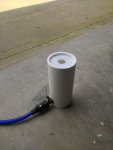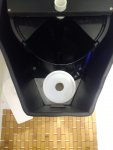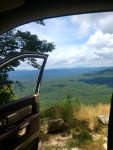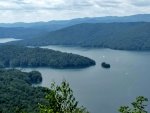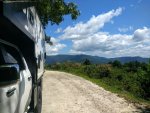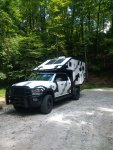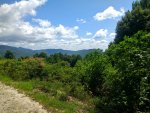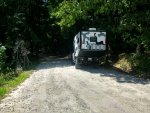I am happy to share my research. I have hundreds of pages of notes, emails from suppliers, technical PDFs and calculations. I have built and sold one box using a factory made panel (EPS core skinned with fiberglass impregnated with a phenolic-based resin) and have experimented with various other cores and skins in an effort to come up with a good quality, DIY friendly recipe. I would not use those panels again, knowing what I know now.
As someone with an engineering background, it is easy to get lost in the details, research until the wee hours of the morning and end up with 50 different ways to build a camper, boat, trailer, tiny house or whatever your heart desires. This is where it gets slippery. You get what you pay for. CAN you build a camper from canvas, Elmer's glue, plywood and old tarps? Yep. Will it be nice? Nope. Will it keep the rain off? Maybe. Will you have to rebuild it at some point? Most certainly.
There are so many factours to consider, namely weight carrying capacity of your vehicle, time frame, skill level of the builder, climate, space to work, budget, friends that can help, just to name a few. Resin is weak, carbon and Aramid are strong. Fiberglass is decently strong. Insulation is cheap, but not really that strong. "Stronger" insulation, such as Foamular 600 or 1000 is really expensive in small quantities. At that point, the slippery slope begins again, and "for a little bit more money" you can buy Plascore, Divinycell or Gurit foam. Fiberglass is cheaper than carbon, so the same rule applies. Is it really cheaper if you have to use twice as much of it or do twice as much work? Ditto for vinylester or other non-epoxy resins. Epoxy has a high price for a reason. It is the best. It is not "expensive" because you are getting a superior product. People have been conditioned to buy price, not quality or longevity or to buy their own time back. If you don't need H80 Diab, epoxy and carbon, what do you need, fiberglass, vinylester and Foamular 150? What do any of us really need? What do you want out of your camper? You asked for a recipe, so I will give you four. Disclaimer: I am not a composites engineer. This data is worth what you paid for it.
Super budget, wood based, not advisable: EPS/XPS foam core and 1/4" plywood skins glued on each side. Insert blocks of wood into the foam where you need to through bolt or mount stuff. Epoxy, bed line or Amercoat the whole thing after you have caulked/sealed all seams with concrete crack filler. A 1" thick foam core, plus a 1/4" skin on each side gives you a 1.5" thick panel with an R-value of 5. Wood campers are heavy, flimsy and do not last long without LOTS of work, and at that point, you could have just built something far superior.
Budget/DIY, decent quality: ACM, Filon, sheet aluminum, Celtec, Phenolic or other sheet good that can be used as a skin, so as to eliminate wet-laying cloth. Use Foamular 150 or 250, lightly sanded for the core, mix up resin roll it on the core, lay the sheet skin down and roll the air out. Do the same thing on the other side and you have a half decent sandwich panel. Rinse and repeat, sealing the edges and corners of the box by wet laying fiberglass or bonding on thin, aluminum angle pieces. Layering or stepping your core creates window and door openings and flanges. This can also be accomplished using a router, but you will need to seal the exposed foam or wet lay cloth.
DIY, good quality, more work: S-glass, carbon or Kevlar fabric (they aren't as expensive as you think), over a Polypropylene Plascore sheet core. Get the real stuff with a veil/scrim, not Chinesium. Repeat the process above by laying 2-3 layers of 200 GSM/6 ounce twill cloth in different directions and rolling/brushing epoxy resin into the cloth. There are tutorials on line. This method is a bit more labour intensive, but the skin bonds with the core better. Additionally, you have strong, light skins and a structural core, not wood over insulation sheets. Cheap roving, CSM and e-glass are not really good options in my opinion.
DIY/Best Quality, more money, but much cheaper than a Bliss box: Purchase Nomex, 5052 Plascore, Divinycell or Gurit foams in the 5 pound density range. Three layers of 3K carbon and 1-2 layers of 3K Aramid on each side create nearly indestructible skins/panels. The advantage of all of these cores is that they are so strong, you can use less of them or use a lighter weight product without losing strength. Example: (made up) - a 2" thick panel made with 1/4" plywood and XPS may have the same tensile or flexural strength as a 1/2" thick panel made with 5056 Hexcell core and three layers of Aramid. You just cut the weight of your panel significantly, freed up space in your camper by using a thinner core, saved on shipping, panels are easier to handle, blah blah blah. You have to look at the big picture, not just, "This costs $100 on Amazon or Alibaba or at Harbour Freight." INVEST in your time, tools, materials and camper box. Cheap men make for cheap goods. Personally, I have held off on building a camper because I want to do it right, once, not build something over and over or go use it and find a bunch of "should-haves". Save your pennies, shop around, collect parts over time, build with a buddy, etc.
Wet layup is easy enough to DIY; watch boat building and surfboard building videos. To make straight flat sandwich panels, a mould or large flat/true work surface is ideal, especially if you are making large panels with Nomex or Hexcell, as they aren't as rigid as foam sheets. Don't cheap out on materials, go slow, take your time, find good suppliers, negotiate, do not use wood or screws or spray foam or anything that can fail and screw up all of your hard work.
Skin thickness: A few layers of 3K or 6K carbon are hell for stout. Top with a layer of Aramid for abrasion resistance or spray the exterior with a two-part Polyurea. Fiberglass 'gives' a little bit; carbon does not, but this really isn't an issue a small truck camper.
Core thickness: Structural cores give up R/U/K-value, as they were not designed to be insulation. So, you should use another product that is design to prevent thermal transfer. Don't try to find one product that does everything. You will be left with a product that does nothing well. A REALLY well made sandwich panel, an inch thick will be incredibly strong, and leave room for insulation, interior finishes or external radiant barrier coatings. Many European builders construct 30mm and 60mm thick walls using fiberglass and XPS foam. Boutique companies such as KCT, make windows and doors to suit these walls.
I put a bid together for a potential client a few years ago, who wanted a simple, flat bed camper. I encouraged him to use sandwich panels made from carbon and Plascore instead of aluminum tubing and skins, but he would not go for it. Materials and a bit of profit for me was in the 10 grand range and dry shell weight was in the 400 pound range. There is no good reason for anyone to have a truck camper made from wood or one that weighs thousands of pounds, IMO. Well, there is, bad design.
If you are willing to remove the bed of your pickup truck and move some things around on the frame, the same techniques described above can be used to fabricate in floor water tanks, shower pans, steps, storage and battery boxes and so on. This adds little weight, increases overall rigidity (you are building a monocoque) and eliminates, "bolting a box or bracket to the bed/frame" in 10 places around the vehicle. Think live well in a boat or built in seating in a boat.
Sorry for the long post, but we are just scratching the surface here. This really is a rabbit hole. Order samples, do your own testing, experiment to see how varying materials behave in your climate or to see if they will fit your needs. There is no such thing as the perfect panel or the perfect camper.

